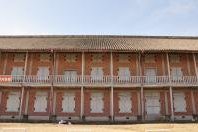
Since the industrial heritage is one of the most underrepresented categories of Asian World Heritage Sites, Japan has started to propose its industrial heritages to fill the gap, Tomioka Silk Mill (Tomioka Seishijou), the first state owned western-styled factory. Almost unknown to foreigners, the factory has been a landmark of Gunma Prefecture since the silk mill is quite famous among Japanese especially in school history class. As part of my 2012 Japan trip, I took the Shinkansen from Tokyo to Takasaki and then the private Joshin Line to Tomioka. From the train station, there was a color line on the road show direction to the mill, the same system uses in many hospitals! After walked for about 15 minutes, I was at the entrance of the complex of large, long brick building. The building turned out to be the eastern cocoon storage, inside there was small exhibition of how to make silk, sadly that there was no English at all. Then I went to see the twin western cocoon storage which was closed for renovation. These two storages were quite the highlight of the mill as they were considered to be the first brick factory building of Japan, the building was done by French and the roof by the Japanese, so it was quite interesting to see the European brick building topped with Japanese tiled roof.
After the storage complex, I went to the silk reeling machine hall, the machine was wrapped by dusty plastic sheet, the very surprising and uninspiring way to preserve the machine. After that I walked around the complex to see dormitories and offices building which mostly built in western styled wooden houses as well as nice river side area. Tomioka Silk Mill was a fine place, but nothing special in my idea. The significance of Tomioka seemed to be its status as the first western style factory in Japan and maybe in Far East and as the showcase of country development as well as the story of its workers. Workers of Tomioka were mainly women who worked 7.45 hours a day 6 days a week, an important chapter of Asian female labor history and welfare development. No surprise that the cartoon image of a female worker, Otomi-chan, has been used as a mascot to promote the World Heritage Site nomination. To become a World Heritage Site, there were support posters and stickers everywhere in town, even on some cars. The complex was also under restoration and refurbishment to prepare the UNESCO registration; however, in my idea Tomioka need to do something more to explain the site and its outstanding value. The display was a big problem, the plastic wrap in the machine hall needs to be put away, and more English explanation signs. This site has great potential, but a long way to go.
In 2014, Tomioka Silk Mill finally has become UNESCO World Heritage Site for its historical importance on Japanese and Asian silk industry. From many news sources there are many developments after my visit, especially new modern train station building to welcome an influx of tourists and new traffic control in city center. Since I am not a great fan of Industrial World Heritage Site, most of them are not beautiful nor is appealing to visit, and unfortunately Tomioka Silk Mill is not different from other industrial heritage sites. However, I really interesting what will happen with Tomioka as I always impressed how the Japanese develop their tourism marketing. Iwami Ginzan is a very good example of their clever to get tourists' money even mining which is probably one of the most uninspiring sites and lacking marketing resources. With its easier money generating silk and mulberry theme souvenirs, Tomioka's tourism chance is the thing that I will look for if I have a chance to go back, maybe new kinds of mulberry rice cakes or DIY weaving silk kit!
More on
Comments
No comments yet.
